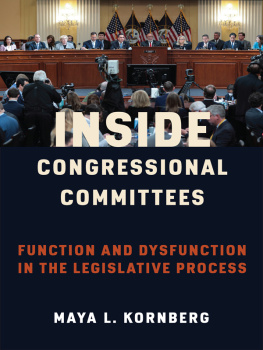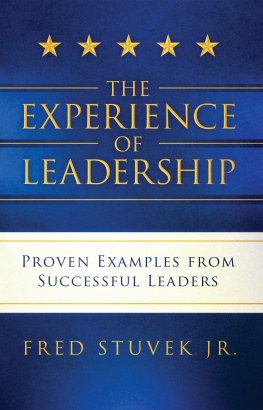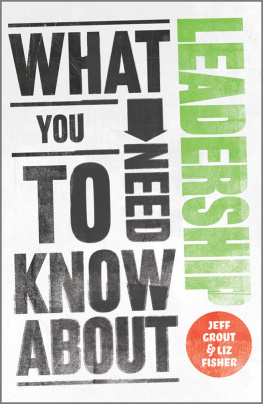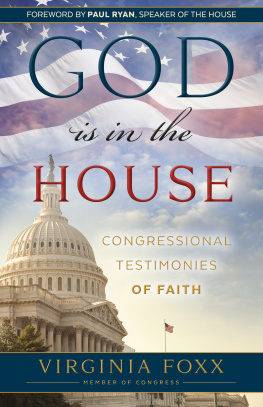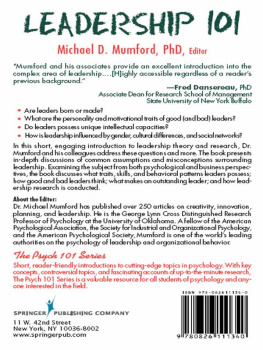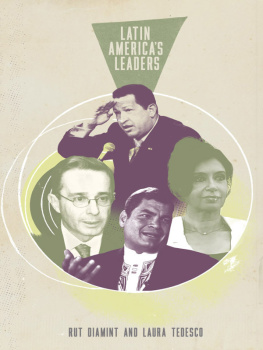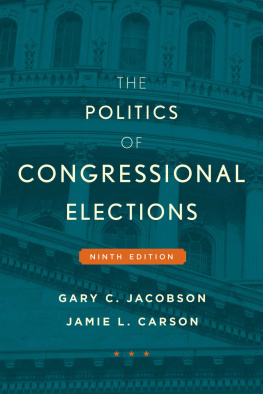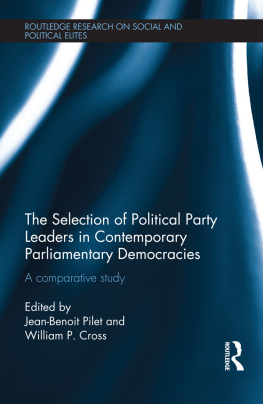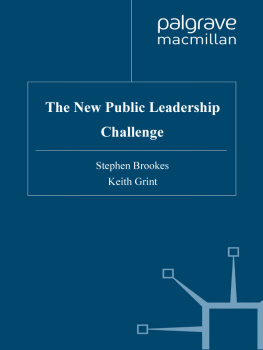CHOOSING THE LEADER
MATTHEW N. GREEN AND DOUGLAS B. HARRIS
Choosing the Leader
Leadership Elections in the U.S. House of Representatives
Yale UNIVERSITY PRESS
NEW HAVEN AND LONDON
Published with assistance from the
Louis Stern Memorial Fund.
Copyright 2019 by Matthew N. Green and
Douglas B. Harris. All rights reserved.
This book may not be reproduced, in whole or in part, including illustrations, in any form (beyond that copying permitted by Sections 107 and 108 of the U.S. Copyright
Law and except by reviewers for the public press), without written permission from the publishers.
Yale University Press books may be purchased in quantity for educational, business, or promotional use. For information, please e-mail (U.K. office).
Set in Janson Oldstyle type by Newgen North America, Austin, Texas.
Printed in the United States of America.
Library of Congress Control Number: 2018944215
ISBN 978-0-300-22257-9 (pbk: alk. paper)
A catalogue record for this book is available from the British Library.
This paper meets the requirements of ANSI/NISO Z39.48-1992 (Permanence of Paper).
10 9 8 7 6 5 4 3 2 1
CONTENTS
PREFACE
The November 2016 elections were a major disappointment for Democrats in the U.S. House of Representatives. Fully expecting to start the next year with Hillary Clinton in the White Houseif not with control of their chamberthey instead would be without a majority in either the House or Senate and forced to deal with a neophyte Republican populist president, Donald Trump. In addition, Democrats hoping to move past the elections and present a unified front to the public faced two potentially divisive races for party leadership posts. A pair of House members had been campaigning for months for the vacant position of caucus vice chair in a race many believed was too close to call. Then, in mid-November, Congressman Tim Ryan (D-OH) declared that he would challenge Nancy Pelosi (D-CA) for the office of minority leader, which she had held since 2011 (Lillis 2016).
The outcomes of both elections promised longer-term consequences for the party. Linda Snchez (D-CA) won the first race, narrowly defeating fellow Californian Barbara Lee by a vote of 98 to 96 and putting her in an advantageous position to move up in the ranks of leadership. The election for minority leader, held two weeks later, was not as closePelosi soundly defeated Ryan, 134 to 63but it was the most votes cast against Pelosi since she first ran for leadership in 2001, and it reflected a growing anxiety among younger Democrats that Pelosi was excluding them from power and failing to provide the direction needed to win future elections (Caygle 2016; Cottle 2016; Kane and OKeefe 2016).
These two racesone for an open seat, the other a revolt against an incumbentexemplify an important but little-understood element of congressional politics. Party leaders in Congress are widely understood to be critical to legislative outcomes, and their selection is not always consensual. In fact, they can be the result of difficult and divisive contests decided by a small handful of lawmakers. But while journalists occasionally cover the ins and outs of these races, there has been little systematic analysis of how legislators make the decisions about whom to support in these elections and, by extension, who is selected to lead them.
We offer such an analysis in this book. In so doing, we reject the conventional wisdom that these elections can be boiled down to ideological preferences, and we disagree with the equally prevalent notion that legislators votes are so individualistic and personality-driven as to preclude generalization. Instead, we argue that two key factors help explain the leadership choice of members of the U.S. House of Representatives: their professional connections with particular candidates, and the extent to which they expect each candidate to help them achieve their goals. We test this new theoretical argument using qualitative and quantitative data, including material collected from over twenty congressional archives around the country, for fourteen leadership races in both political parties over the past six decades.
We have many people to thank for helping bring this study to fruition. A number of current and former lawmakers and congressional staff were willing to sit down for interviews to share their priceless knowledge of leadership races, for which we are most grateful. Attendees at Georgetown Universitys American Government Seminar Series offered valuable suggestions and critiques for part of our research, including Michael Bailey, Jonathan Ladd, Hans Noel, and Michele Swers. Special thanks to the Historian of the U.S. House of Representatives, Matthew Wasniewski, for his beneficial ideas and for inviting us to present our research to members of the House Historians office. We are indebted to Michael Hanmer for his statistical advice, Sean Kelly and Scott Frisch for generously sharing data on the 2006 majority leader race, and Sarah Treul for kindly providing us her then-unpublished manuscript on congressional state delegations. Additional helpful advice and suggestions came from Brian Alexander, Emily Baer, Stephanie Burkhalter, Anthony Champagne, Maurice Cunningham, Bill DAntonio, Victoria Farrar-Myers, Danny Hayes, Soren Jordan, Nathan Kalmoe, David Karol, Ken Kato, Jennifer Lawless, Eric Lawrence, Frances Lee, Jeffrey Lewis, Bryan Marshall, David Mayhew, Scott Meinke, Garrison Nelson, Hong Min Park, Keith Poole, Eric Powers, Paul Quirk, Jim Riddlesperger, John Sides, Steve Wenzel, Don Wolfensberger, and Antoine Yoshinaka. Doug Harris would especially like to thank, in memoriam, Sukie Hammond and Bob Peabody, who first taught him the importance and excitement of studying legislative leadership selection.
We are most grateful for the help from staff and archivists at the many congressional collections where we gathered data. They include, but are not limited to, John Atteberry, Laura Berfield, Kristen Chinery, Brad Coffield, Janet Dotterer, Amara Edwards, Jeffrey Flannery, Nathan Gerth, Teresa Gipson, Chris Gordon, Carolyn Hanneman, Rachel Henson, Myron House, Frank Mackaman, Roger Myers, Charles Niles, Sean Noel, John OConnell, Marilyn Parrish, Lisa Pea, Geoffrey Reynolds, Jill Severn, Jeffrey Thomas, and Lori Tretheway. Financial assistance was provided by the Everett McKinley Dirksen Congressional Research Center, the Carl Albert Congressional Research and Studies Center, the Morris K. Udall Research Grant program, and the summer research grant program at Loyola University Maryland.
We are especially grateful to Bill Frucht of Yale University Press, who not only endorsed our project but guided it through the review process with diligence and enduring patience. The anonymous reviewers of our manuscript provided trenchant critiques and valuable guidance, which we greatly appreciate.
Finally, we want to thank our families for their support. Matthew thanks his wife, Holly, and children, Joshua and Olivia (the uncredited cover photographer of his previous book), who silently endured the many hours he sat hunched over a laptop and his occasional disappearances to distant archives. Doug thanks his wife, Christine Kempf, and daughters, Zoe and Maya Kempf-Harris, for the daily entertainment, patience, and love.
CHOOSING THE LEADER
one
CHOOSING THE LEADER
Party leaders in Congress matter. They shape the agenda and the rules of their chamber, control lawmakers access to internal information, and assemble and enforce collective agreements within the legislature. They negotiate on behalf of their colleagues with interest groups and elected officials outside of Congress, and they serve as their partys public face to other branches of government, the press, and the public. They also participate in electoral politics, developing partisan messages, raising campaign funds, and recruiting electoral candidates (Cox and McCubbins 2005; Curry 2015; Harris 1998; Mayhew 1974; Peabody 1976; Sinclair 1995; S. Smith 2007; Strahan 2007).
Next page

